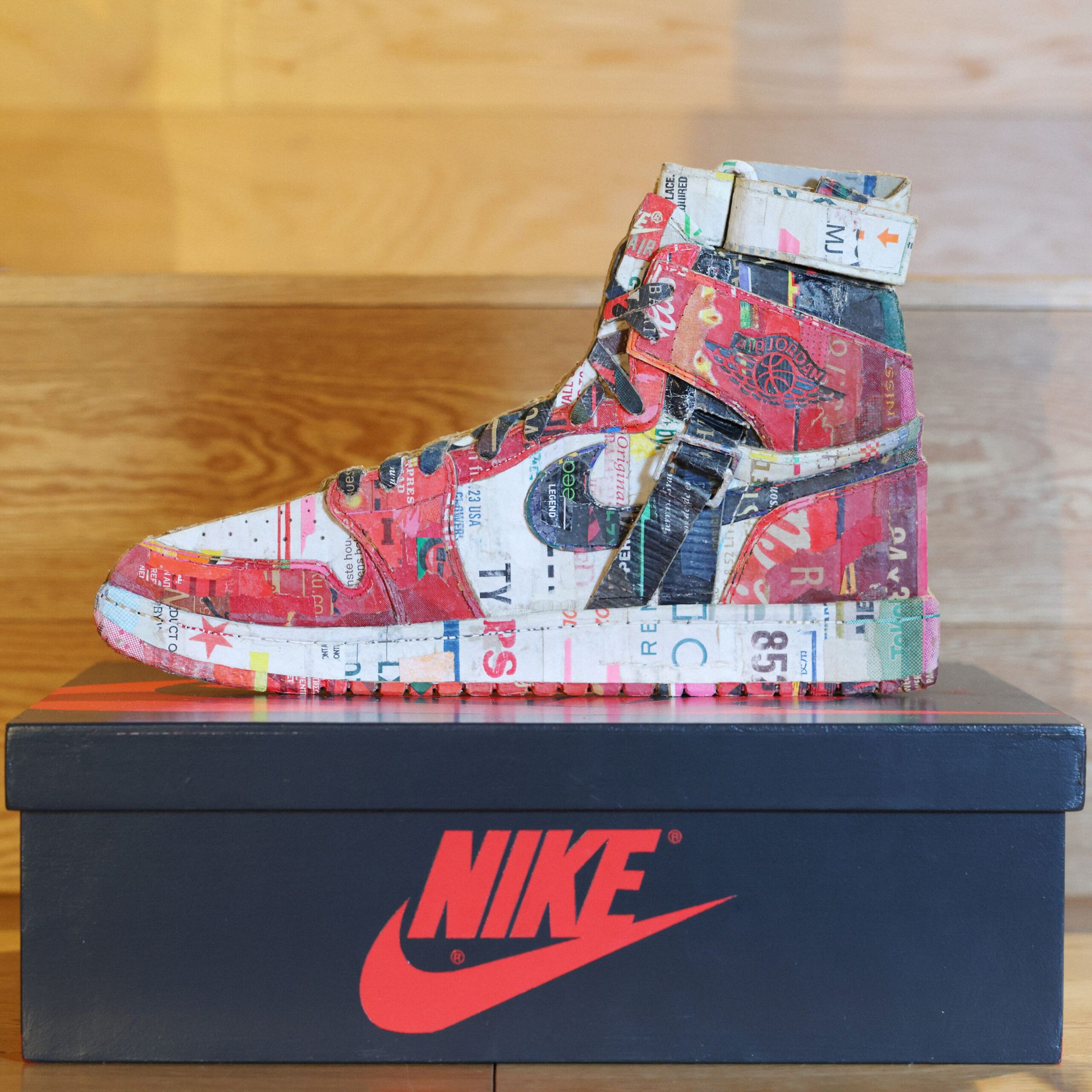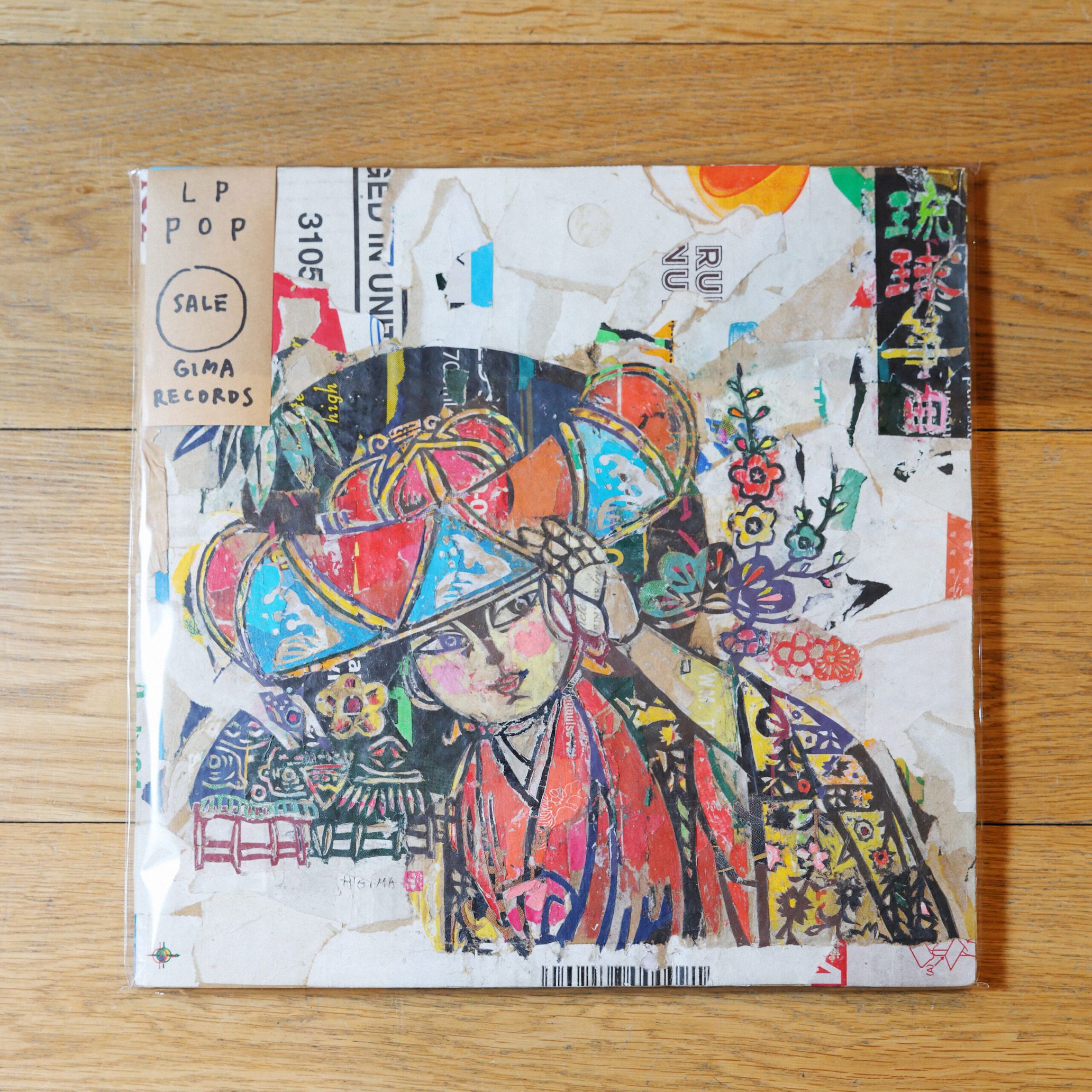In January, artist Tomotatsu Gima’s art exhibition, POP COLLAGE LP+SNEAKER took place at hotel koe tokyo located in Shibuya, Tokyo. Stepping inside the solo exhibition, I witnessed an array of Gima’s works, including his sought-after sneaker artwork and collection made from analog records of popular artists from the 80s and the 90s, displayed as if in a sneaker and vintage record shop.
Gima reuses waste cardboard and transcends them into glorious art pieces with his original technique.
We will be providing this interview in two installments, unveiling the artist’s works in his latest solo exhibition and his past journey as an artist. In Part One, we talk about his first-ever analog record cover series he exhibited at the solo exhibition. With his devotion to music being the drive for his creative production, it is astounding that he accomplished producing approximately eighty intricate pieces within mere six months.
Some of the works I made are more detailed than the originals
ーーI heard it’s your first time showcasing works made based on existing album covers. So, what’s the motive behind this new collection, POP COLLAGE LP?
Tomotatsu Gima (Hereinafter Gima): While preparing works for this exhibition, I listened to music and had some time checking out their record covers. Then, I found many brilliant cover arts designed by the famous artist Andy Warhol. His art covers make me feel like I’m looking at art paintings, and the records are packed with memories and nostalgic songs I used to listen to when I was in school. I always thought it would be cool to showcase my record collection. Plus, the exhibition is held in Shibuya this time, which is a city of music sanctuary, so I thought it would make sense to do an analog record theme. So, we planned the exhibition and made record artworks to be the main thing.
ーーWhich artist’s album cover was your first record artwork?
Gima: The earliest works were Velvet Underground’s debut album, Velvet Underground & Nico, which the cover was designed by Andy Warhol; and Sonic Youth’s Goo. I love the cover designs, and I used to listen to their songs all the time, so that’s why I chose these two for my first works of the collection.
Also, for this LP exhibition, I wanted to produce and show as many artworks as possible. But I couldn’t do so if I did it the way I usually do with my other works. So, to have everything ready by the opening, I came up with a new and faster medium and tried it out to see if it worked. As a result, it worked and I discovered my new standard technique.
ーーEven though you speed up the production, it’s incredible how the artworks are intricately re-created (made.)
Gima: Although I came up with a new medium, it took a lot of effort to produce them. I can say this because I do illustrations, but some of my works are more detailed than the originals. The entire process has gotten faster than usual. But of course, every work was done meticulously. With the new method and the right amount of time, I was able to make each piece close to what I’d envisioned it to be. My goal was to discover a new me by the time I finished making many record artworks.
ーーBy the way, what’s music to you? I presume there’s a meaning behind recreating album covers or things spawned from music culture.
Gima: I’m more into rock songs, and Nirvana’s Nevermind was the record that got me into music. Actually, it was after Kurt Cobain died my senior from my school told me about the band Nirvana. I thought they were really cool when I heard their music and got obsessed with them. And in college, there was a period where I was feeling down, and during that time, I was really saved by Curt through his lyrics as there were a lot I could relate to. I’m often attracted to bands that sing songs with profound messages, have a rebellious side, and have confidence in themselves. So other than Nirvana, I’m into bands like Rage Against the Machine. Their strong messages were essential in society back then, but I think they are still in need today. I feel like there are fewer chances to be vocal and manifest your thoughts in Japan, but I think it’s sometimes important to speak your opinions out loud and fight to object. I wouldn’t say rock bands are the key in this exhibition, but I hope my works provoke curiosity and make people think, “What were these artists singing about?” and look back on the words these artists we’re putting out there.
ーーI absolutely feel the prominent power of music.
Gima: You need to break away from conventional ideas to be off the beaten path and emit strong words. And I think it requires immense energy, powerful words and performances to do so. So I respect those people who manage to do these things. They are the inspirations of my creative energy, and they give me power. So in that sense, it’s cool that I’m now 45 and creating works inspired by my favorite music that empowered me when I was in my 20s.
ーーOther than the technical stuff, what are the things you discovered through making the artworks?
Gima: I had a goal of upgrading myself and believed that I would discover a new self if I worked hard enough, but it was tough because I had to stay up all night towards the deadline. In the manga Slam Dunk (by Takehiko Inoue), there’s a part where the coach tells the protagonist Hanamichi Sakuragi that he will improve if he does twenty-thousand shots. I couldn’t make twenty-thousand art pieces, but I was imagining that scene as I worked. [Laughs]
What I do is exactly what I had practiced in my college years
ーーI’ve noticed there are vertical lines in your artworks—Can you tell me what these lines are?
Gima: It’s part of my art style. Sometimes paint drips when oil painting, but I prefer keeping it on my works. This style comes from my experience in college. Ultimately, things I do now is based on what I had learned back in high school and college. I intentionally incorporate a lot of vertical lines in my works, which comes from what I’d learned from oil painting in school. It’s my signature style or medium so that when people see my works, they can tell, “Oh, this must be Gima’s.” I wanted to make this my signature medium from the get-go.
ーーSo your style originates from what you had learned back in school. What’s the new medium you applied for your works this time?
Gima: For example, for the ones with a white background and black fonts, I put a black sheet of paper under a white paper so that black appears when I cut out. This technique comes from painting. In painting, there’s a technique of letting the paint on the base layer dry completely and scratch it while the top paint layer isn’t dry yet—It’s exactly that. Basically, what I do is exactly what I practiced in school. Also, for the RUN DMC one I have for this exhibition, there’s more black on the original, but I added more white and recreated it into my style. Sometimes I make them look the same as the originals, but sometimes, I stop cutting where I think it’s cool. Without looking too different from the sources, I wanted to infuse my style into them, and at the same time, use the texture of the cardboard to convey nuances—I was thinking multiple things while making these artworks.
ーーSo instead of just copying the originals entirely, you are transcending their designs and turning them into something new.
Gima: I used to hesitate a lot in doing so, but I’m over it now and can draw a line between the originals and my works. Honestly, it’s easier just to imitate the originals. There are primarily two things I need to decide while making: How I want them to look in the end and where to stop. And I think I’m getting better at making up my mind on these things. I believe everyone wants to see something new. And that’s the same for me as well. So I’m always seeking to update things and create something cool.
Tomotatsu Gima
Gima was born in 1976 in Okinawa. After graduating from Nagoya University of Art, where he majored in fine art, he flew to New York in 2004 and studied there for a year. He then came back to Okinawa and started his career as an artist. After joining many group exhibitions, in 2018, he accomplished his first solo exhibition, titled SOME POP, based around the theme, “Distribution and Consumption,” and earned a lot of praise. He later launched the brand rubodan, selling notebooks and letter sets made from reused cardboard. He also travels around Asia, communicating with locals and opening workshops, and collaborates with Orion beer, producing stationery sets made from reused cardboard with the goal of zero waste.
Instagram @tomotatsu_gima / @rubodan
http://www.rubodan.com
Photography Shinpo Kimura
Translation Ai Kaneda
















